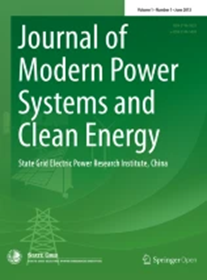A Review of State-of-the-Art Flexible Power Point Tracking Algorithms in Photovoltaic Systems for Grid Support: Classification and Application
IF 5.7
1区 工程技术
Q1 ENGINEERING, ELECTRICAL & ELECTRONIC
Journal of Modern Power Systems and Clean Energy
Pub Date : 2023-10-04
DOI:10.35833/MPCE.2022.000845
引用次数: 0
Abstract
To maximize conversion efficiency, photovoltaic (PV) systems generally operate in the maximum power point tracking (MPPT) mode. However, due to the increasing penetration level of PV systems, there is a need for more developed control functions in terms of frequency support services and voltage control to maintain the reliability and stability of the power grid. Therefore, flexible active power control is a mandatory task for grid-connected PV systems to meet part of the grid requirements. Hence, a significant number of flexible power point tracking (FPPT) algorithms have been introduced in the existing literature. The purpose of such algorithms is to realize a cost-effective method to provide grid support functionalities while minimizing the reliance on energy storage systems. This paper provides a comprehensive overview of grid support functionalities that can be obtained with the FPPT control of PV systems such as frequency support and volt-var control. Each of these grid support functionalities necessitates PV systems to operate under one of the three control strategies, which can be provided with FPPT algorithms. The three control strategies are classified as: ① constant power generation control (CPGC), ② power reserve control (PRC), and ③ power ramp rate control (PRRC). A detailed discussion on available FPPT algorithms for each control strategy is also provided. This paper can serve as a comprehensive review of the state-of-the-art FPPT algorithms that can equip PV systems with various grid support functionalities.光伏系统中用于电网支持的先进灵活功率点跟踪算法综述:分类与应用
为了最大限度地提高转换效率,光伏(PV)系统通常以最大功率点跟踪(MPPT)模式运行。然而,由于光伏系统的渗透率越来越高,需要在频率支持服务和电压控制方面开发更多的控制功能,以保持电网的可靠性和稳定性。因此,灵活的有功功率控制是并网光伏系统满足部分电网要求的必修课。因此,现有文献中引入了大量灵活功率点跟踪(FPPT)算法。这些算法的目的是实现一种具有成本效益的方法,以提供电网支持功能,同时最大限度地减少对储能系统的依赖。本文全面概述了光伏系统的 FPPT 控制可实现的电网支持功能,如频率支持和电压-伏特控制。每种电网支持功能都要求光伏系统在三种控制策略之一下运行,而 FPPT 算法可提供这些控制策略。这三种控制策略可分为恒功率发电控制 (CPGC)、②功率储备控制 (PRC) 和③功率斜率控制 (PRRC)。本文还详细讨论了每种控制策略的可用 FPPT 算法。本文可作为对最先进的 FPPT 算法的全面回顾,这些算法可为光伏系统提供各种电网支持功能。
本文章由计算机程序翻译,如有差异,请以英文原文为准。
求助全文
约1分钟内获得全文
求助全文
来源期刊

Journal of Modern Power Systems and Clean Energy
ENGINEERING, ELECTRICAL & ELECTRONIC-
CiteScore
12.30
自引率
14.30%
发文量
97
审稿时长
13 weeks
期刊介绍:
Journal of Modern Power Systems and Clean Energy (MPCE), commencing from June, 2013, is a newly established, peer-reviewed and quarterly published journal in English. It is the first international power engineering journal originated in mainland China. MPCE publishes original papers, short letters and review articles in the field of modern power systems with focus on smart grid technology and renewable energy integration, etc.
 求助内容:
求助内容: 应助结果提醒方式:
应助结果提醒方式:


